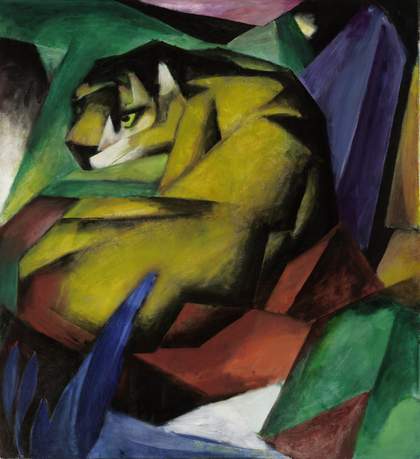In the early 20th century, an international circle of friends came together to push the boundaries of art. Formed in Munich in 1911, The Blue Rider were a community of painters, performers and musicians including Wassily Kandinsky, Gabriele Münter, Franz Marc and Marianne von Werefkin. Together they took creative risks that would define modern art. In celebration of the new exhibition at Tate Modern, we look at this collective in more detail:
Who Were The Blue Rider?
Discover the groundbreaking work of a circle of friends and close collaborators known as The Blue Rider
Friendship was the heart of their creative circle
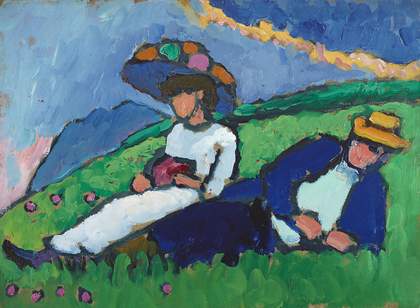
Gabriele Münter Jawlensky and Werefkin 1909 Lenbachhaus Munich, Donation of Gabriele Münter, 1957 © DACS 2024
Friendship was one of the community’s strongest ties as they bonded over their love of art. A multicultural circle of close-knit, diverse personalities, they shared artistic ideas across different nations. Murnau, a rural town in the foothills of the Bavarian Alps, became an important place for the circle who spent many summers there together. Inspired by its picturesque outdoor spaces, they visited to relax, work and experiment creatively.
Experimenting with colour, light and sound they created exciting new works and were happy to pose as models for each other. Gabriele Münter’s Jawlensky and Werefkin (1909), a vibrant painting of fellow Blue Rider artists Alexej Jawlensky and Marianne von Werefkin enjoying a moment in a meadow, is just one example of these works.
‘We were only a group of friends who shared a common passion for painting as a form of self-expression. Each of us was interested in the work of the other … in the health and happiness of the others.’
– Gabriele Münter
Colour and music hugely influenced their paintings
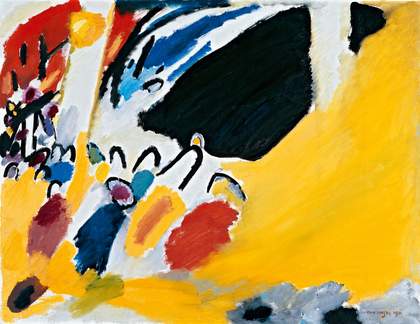
Wassily Kandinsky Impression III (Concert) 1911 Lenbachhaus Munich, Donation of Gabriele Münter, 1957
The Blue Rider artists believed in the power of colour and composition. Franz Marc adopted a colour theory for his works – blue for masculinity, yellow for femininity, and red symbolising the intensity of the world. He was said to look through Prisms, seeing ‘rings of colours’ as he layered his canvas’ with different shades.
Kandinsky, in particular valued the connection between music and colour. He described ‘the sound of colours’ where he was able to ‘hear’ his paintings, with colours and shapes having their own sounds and tones. Inspired by a concert by experimental composer Arnold Schoenberg, Kandinsky painted Impression III (Concert) (1911), where a black angular block piano seems to float on a wave of yellow sound.
They used theatre and performance to explore identity
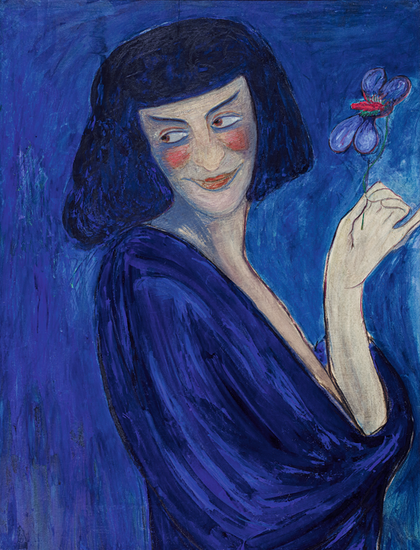
Marianne Werefkin The Dancer, Alexander Sacharoff 1909 Fondazione Marianne Werefkin, Museo Comunale d'Arte Moderna, Ascona
Theatre was a safe space for the artists to explore sexuality and gender – they expressed themselves freely in roles that challenged society’s norms. Russian-born painter Marianne von Werefkin dedicated much of her time to being a patron of the arts. She immersed herself in unconventional street theatre as she experimented with painting. Resenting gendered labels, she said: ‘I am not a man, I am not a woman, I am I.’
Dancer and choreographer Alexander Sacharoff embraced a fluid, androgynous identity on (and off) stage through groundbreaking free-movement performances. He wore flamboyant costumes, like metal wigs and hats decorated with flowers and wax fruit. Sacharoff also enjoyed posing for portraits in different guises, as he did for Werefkin's provocative, playful The Dancer, Alexander Sacharoff (1909).
Folk and children’s art inspired them
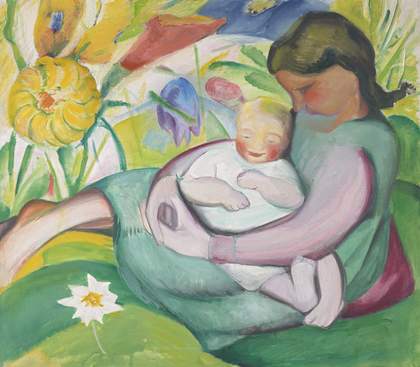
Maria Franck-Marc Girl with Toddler circa 1913 Lenbachhaus Munich
The circle was curious about art from many cultures, striving to create art ‘that knows no borders.’ They collected folk artworks and artefacts and were inspired by images depicting nature and spirituality. Franz Marc, for example, explored this in his paintings, believing animals represented a spiritual world. The name The Blue Rider also refers to a key motif in Kandinsky and Marc’s work: the horse and rider. They believed the rider symbolised the ability to move to another world, with blue seen as the most spiritual of colours.
Many in the circle were interested in children’s art. Fascinated by children’s creativity, Maria Franck-Marc's expressive paintings feature children playing and using imagination. In Girl with Toddler (c. 1913), the young girl pretends to be a mother, lovingly cradling a rosy-cheeked toddler in dreamy, innocent surroundings of flowers and shades of colourful light.
They experimented with different mediums like photography
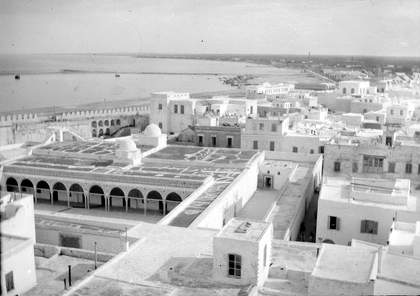
Gabriele Münter Sousse, View of the City and Harbour from the Ribat Tower 1905, printed 2006-7 The Gabriele Münter and Johannes Eichner Foundation, Munich © DACS 2024
As one of the women who founded the movement, Gabriele Münter played a crucial role in creating new ground for women artists. Primarily a painter, she experimented with different techniques and had a skilled photographer’s eye from an early age. Fascinated by people, she often used her No.2 Bull’s-Eye Kodak (one of the first mass-market cameras) before making sketches on paper.
A keen traveller, Münter took hundreds of photos during her journeys across Europe, the USA and Africa in the 1900s. She was drawn to classic Tunisian architecture, focusing on their striking geometric shapes. Many of these shots have a cinematic quality, a reflection of her lifelong love of film. Münter also photographed women in different roles in Tunisian city life, from mothers to travellers and camel riders.
Expressionists: Kandinsky, Münter and the Blue Rider is on at Tate Modern until 20 October 2024


